Fujifilm Finepix S1 Review
Fujifilm Finepix S1 Introduction
The Fuji Finepix S1 is the Fuji flagship consumer-grade ultra-zoom and the first one to be fully weather-sealed. It boasts an extremely powerful ultra-wide 50X optical zoom lens with a 5-axis image-stabilization mechanism and a brighter-than-usual F/2.8 - 5.6 maximum aperture. The lens is paired with a 16 megapixels 1/2.3" high-speed CMOS sensor capable of shooting continuously at 10 FPS.
The Fuji S1 combines a number of advanced features, including full-manual controls, exposure bracketing, custom white-balance, choice of metering and a standard hot-shoe. Its body is weather-sealed against rain, snow and dust. It also features a single control-dial, a built-in 0.2" EVF with 920K pixels and a 3" LCD of the same resolution.
The high-speed CMOS sensor delivers class-leading video performance with full 1080p HD at 60 FPS and 640p SD at 120 FPS for ultra-smooth action. It also offers high-speed video up to 240 FPS at lower-resolutions.
This DSLR-styled ultra-zoom is designed for shooting stability with a strong and wide lens barrel with its own zoom-controller. This follows what Fuji originally introduced in the SL-series which feature varying zooms up to 50X too and covering the same stellar 24 to 1200mm range yet not as bright.
This express digital camera review analyses the features, ergonomics, usability, performance and image quality of the Fuji Finepix S1.
Fuji Finepix S1 Features
Sensor & Exposure
- 16 Megapixels 1/2.3" CMOS sensor
- ISO 100 - 3200 sensitivity range at full-resolution
- Expanded ISO 6400 @ 8 MP, 12800 @ 4 MP
- 1/2000 - 30s Shutter-speeds
- PASM Exposure modes
- Program-Shift in P mode
- Exposure-Compensation, ±2 in 1/3 EV increments
- Multi-Segment, Average, Spot & Face-Detect metering
Lens
- 50X Optical zoom range
- Ultra-Wide-Angle 24-1200mm equivalent
- 5-Axis Stabilization, Shooting-Only or Continuous
- F/2.8 - 5.6 Maximum aperture
- F/11 Minimum aperture
- 40cm (W) -1.5m (T) Normal focus distance
- 5cm (W) - 1.3m (T) Macro focus
- 1cm (W only) Super-Macro focus
- Zoom Framing-Assist function
- Optional MF Assist
Image Parameters
- Automatic, 6 presetsSunny (Fine), Shade, Fluorescent 1, Fluorescent 2, Fluorescent 3, Incandescent and custom white-balance
- Standard, Chrome, B&W color modes
- 4:3 Native sensor aspect-ratio
- 3:2, 16:9 and 1:1 crop modes
- JPEG or RAW output
- Motion Panorama (120°, 180° or 360°) mode
- 16 Scene Modes
- Built-in HDR blending
- Multi-Frame Noise-Reduction
Video
- 1920x1080 @ 60 FPS Full HD video
- 1280x720 @ 60 FPS HD video
- 640x480 @ 120 FPS SD video
- 640x480 @ 30 FPS SD video
- 320x240 @ 240 FPS High-Speed video
- 240x180 @ 480 FPS High-Speed video
- Built-in stereo microphone
- Single-Shot or Continuous Autofocus
- Quicktime H.264 codec
Focus
- Center-Focus
- Automatic Focus Selection
- Manual Focus Selection
- Continuous Autofocus
- Tracking Autofocus
- Face-Detect Autofocus
- Manual Focus
- Optional AF Assist-Lamp
Drive
- 10 FPS, Max 9 frames
- Best-Frame Capture
- Self-Timer, 2s or 10s
- Interval Timer, 15s-10m for 5m-6h
Flash
- Flash-Compensation, ±2/3 in 1/3 EV increments
- Exposure Bracketing, 3 frames, maximum ±1 EV
- Auto, Auto-Redeye, Forced, Redeye, Slow-Sync, Slow-Sync Redeye or Off flash modes
- Built-in popup flash, 8m (W) - 4m (T) range
- Standard Hot-Shoe
Display & Viewfinder
- 3" LCD, 920K Pixels, 97% Coverage
- 0.2" EVF, 920K Pixels, 97% Coverage
- Optional Live-Histogram
- Grid or HD Guidelines
- Adjustable LCD brightness
Misc
- Weather-sealed
- Single control-dial
- WiFi, 802.11b/g/n
- HDMI (1080i) output
- USB 2.0 connectivity
- SDXC memory
- Lithium-Ion battery
Fujifilm Finepix S1 Usability - How easy is it to use?
The Fuji Finepix S1 has a classic ultra-zoom style, keeping it looking like a slightly shrunk DSLR. All cameras with such extreme optical zooms are designed this way. The protruding lens barrel is a necessity to house a 24 to 1200mm equivalent lens.
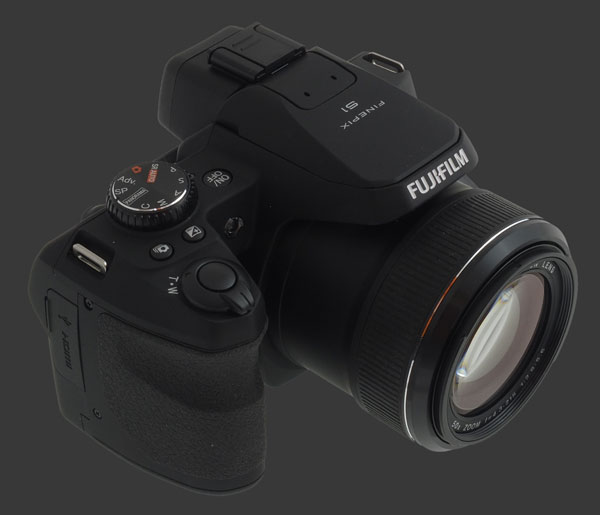
This digital camera has a deep sculpted hand-grip which makes it comfortable to hold securely. This is crucial for an ultra-zoom since it improves stability which is essential towards the long end of the zoom. The broad lens barrel provides another point to support the S1 which should be used with both hands. An imitation focus-ring made of textured rubber provides added traction.
The S1 offers dual zoom-controllers. A traditional one around the shutter-release, plus one on the outer side of the lens barrel. Both are easy to reach and operate. The S1 feels solid and has a smooth silky matte finish. The angular design contributes to a prosumer feel. This makes it look more serious and luxurious than the higher-end X-S1.
The hand-grip houses a number of controls including a standard two-stage shutter-release. Around it is a rotating zoom controller which moves the lens electronically in discrete steps, making precise framing not always possible. Just behind are the easily accessible EC and Drive-Mode buttons occupying prime real-estate. It would have been preferable if ISO was there instead of the latter.
The Drive-Mode button offers a horizontal menu of 6 drive modes which surprisingly do not include any self-timers. Behind these two buttons, there is a traditional mode-dial with 10 positions. The mode dial is easy to move using your thumb while holding the camera securely. It has good detents which means it will not move accidentally either.
A recessed power-button, just to the left of the mode-dial, turns the camera on and off. This one is sufficiently large to operate and level enough to avoid accidental use. The top of the Fuji S1 shows its built-in flash and standard hot-shoe with a stereo microphone placed between the two.
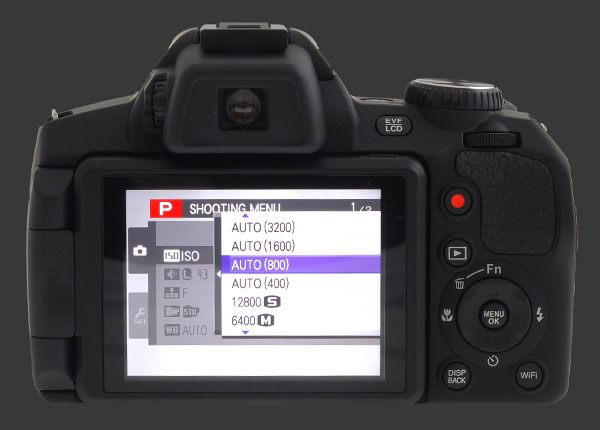
The back of the Fuji Finepix S1 is very busy. Besides a rather small rubber-patch that serves as thumb-rest, the remainder is entirely used. Dominating the view is a high-resolution 3" LCD with 920K pixels. The display is mounted on a rotating hinge on the left. This makes it inconvenient when shooting at elevated or low angles but makes framing self-portraits possible. This is also clearly the weakest point on this camera and the only part which shows some flex, so be careful when the LCD is extended.
Just above the LCD is an EVF of the same resolution. Unfortunately is is small, very dim and low-contrast. This makes it border on useless yet still better than nothing under bright light when the rear screen gets completely washed out. In low-light, the EVF is too dark to use. The LCD fairs better in such conditions but not by much.
Neither display is Exposure-Priority and both suffer from excessive lag when the scene changes brightness. It can take a few seconds for a completely blown-out preview to start showing details. Needless to say, neither the EVF or LCD is suitable for following action.
To the right of the EVF, there is an angled button that toggles between the viewfinder and LCD. This is the only way to switch between the two. Note that the Fuji site incorrectly says there is an Eye-Start sensor on the S1. It would have been nice but the only the X and HS-series have it. Further right there is a slim control-dial with good detents. It only protrudes slightly, so not great while wearing gloves but completely usable otherwise.
Most remaining controls are cramped to the right of the display. At the top, there is a recessed Video Record button. It is hard to accidentally press. However, with the camera at eye-level, it can be mistaken for the similar Playback button just below it. There is unfortunate delay of almost 2s to start filming but stopping is instant. A delay of about ¼s occurs when returning to Capture mode, while entering Playback mode is instant.
The 4-way controller right below is used to navigate the menu. Outside of the menu, which is invoked by the central OK/Menu button, each direction has an assigned function:
- Up: Activates one of 10 functions. ISO is the ideal candidate here. Prompts for deletion in Playback mode.
- Right: Cycles through flash modes when the flash is raised. Options are Auto, Forced, Slow-Sync. An option in the Setup menu controls whether redeye reduction is used or not. There is no Off because that is automatic when the flash is closed.
- Down: Brings up the self-timer menu and cycles through each option: Off, 10s, 2s or Interval-Timer. Annoyingly, self-timers reset after each use.
- Left: Cycles through Normal, Macro and Super-Macro focus modes. The Super-Macro mode automatically zooms out completely which allows the S1 to focus down to 1cm from the lens.
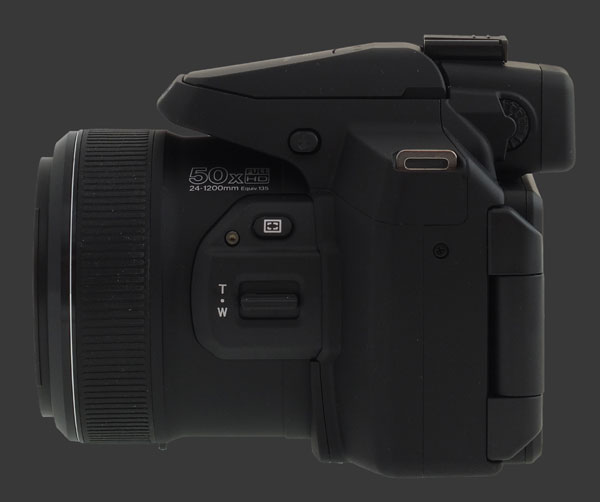
There are two controls on the left side of the lens barrel. One is the already mentioned zoom-controller. It moves the lens in discrete steps faster than the one wrapped around the shutter-release. For less imprecise framing, the latter is therefore preferable. The second control is a button which temporarily zooms-out while held. This is of use when trying to frame a distant subject and helps aiming the camera in the right direction.

There is plastic tripod mount at the bottom of this camera. It is not aligned with the optical center of the lens which is problematic for panoramic photography. The camera is powered by a proprietary Lithium-Ion battery. The camera accepts SDXC memory cards. A solid door at the bottom of the camera gives access to both.
Fujifilm Finepix S1 Performance - How well does it take pictures?
Fuji currently has the most ultra-zooms of any camera manufacturer. More importantly, its high-end models are quite varied. The Fuji Finepix S1 is the new flagship S-series and sits above the SL-series by offering all their features and then some in a weather-sealed body. None of the HS-series are weather-proof but they offer more refined controls and superior ergonomics. The top-of-the-line X-S1 combines the best of the S1 and HS-series while featuring a larger 2/3" CMOS sensor.
Image Quality
The 16 megapixels 1/2.3" CMOS sensor of the S1 delivers average image-quality. Its processing parameters are fixed, unless shooting RAW, and favor low-noise over retention of details. This looks reasonable at small sizes. However, when viewed at 100%, images look distinctly like water-colors. There are no controls over any aspect of noise-reduction or sharpness.
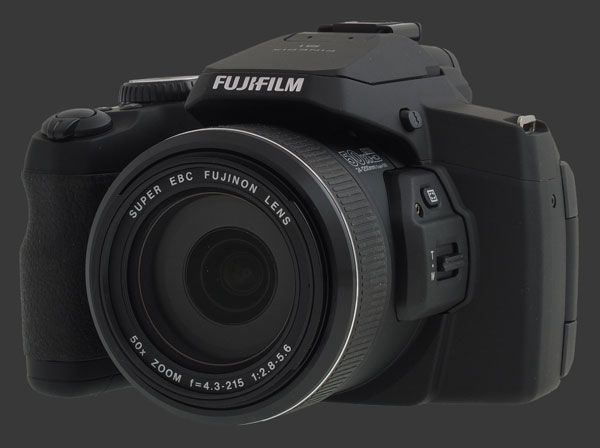
ISO 100 clearly offers the best image-quality and maximum print sizes. It is suitable for typical mid-sized prints and 12" x 9" ones look quite good. ISO 200 and 400 are nearly identical, showing slightly softer details due to aggressive noise-reduction.
The ISO 800 sensitivity is only slightly worse but certainly puts a tighter limit on print-size. Still, bright mid-size prints appear reasonable. Darker ones show more muddled details but remain usable. Images taken at ISO 1600 are quite blurry and devoid of details. A small print may come out usable but that is it. Anything beyond is not usable, nor would we expect it to be for such a small sensor.
Dynamic-range is a serious problem for the S1. Its tiny pixels have little depth and only capture a limited range of tonalities. This makes images appear harsher than reality, as if someone artificially increased the contrast artificially. There is no way to adjust this either, other than shooting RAW. Even so, making the contrast natural will make images appear rather dull.
Built-in HDR lets the Fuji S1 capture more dynamic-range by blending multiple frames together. Fuji does an excellent tone-mapping job to produce the resulting image. Because of the blending though, details get even softer. As seen above, it still looks reasonably good at reduced sizes.
The incredible 50X optical zoom lens certainly delivers more than the sensor. Details are rendered consistently from corner-to-corner and there is no sign of vignetting or chromatic aberrations. A slight barrel distortion can be noticed at wide-angle but it quickly disappears after zooming-in just a little.
Color accuracy is reasonable. There is slightly too much red in Standard mode. The Chrome mode increases saturation while keeping hue close to reality. Those are the only two color-modes on the S1 and neither can be refined in-camera. The WB system is better than average and keeps colors neutral under most types of lighting.
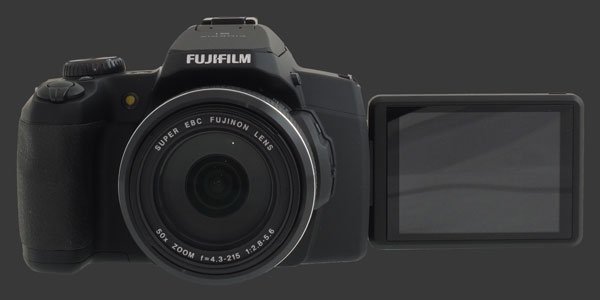
The multi-segment metering of the Fuji Finepix S1 does a fine job when presented with most scenes. At night, when contrast is high, it tends to blow-up highlights more than we would like. Since the dynamic-range is low though, expect a lot of clipping even after adjusting EC to avoid over-exposure.
Speed & Performance
Speed of the S1 is generally quite impressive. Its performance is characterized by the following measurements:
- Power On: 1s. Good..
- Autofocus: Around ¼s in good light near wide-angle but typically closer to ½s. Very good.
- Zoom: About 2s from widest to longest. Great.
- Image Shutter-Lag: Instant. Excellent.
- Video Shutter-Lag: 2s. Very slow.
- Black Out: ½s. Above average.
- Shot-to-Shot speed: 1s. Average.
- Time-to-first shot: 1½s. Good.
- Playback: About Instant to enter, ¼ to exit. Very good.
- Power Off: Under 1½s from wide-angle. Up to 2½s from telephoto. Good.
This digital camera is extremely responsive. When a button is pressed, the S1 reacts instantly, except for the DISP button in Playback mode which lags behind a little.
At 350 shots-per-chage, battery-life of the Fuji Finepix S1 is average for a modern digital camera but short when compared to similar ultra-zooms. The Fuji S1 unfortunately charges internally via USB, so one cannot charge a second battery while using the camera. An optional BC-85A charger is available for purchase though and takes 3 hours to fully charge a single NP-85 battery.
Fujifilm Finepix S1 Conclusion
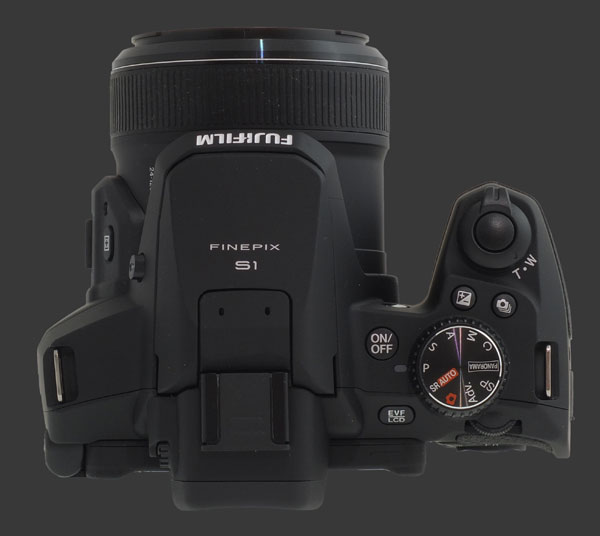
The Fuji Finepix S1 is a capable and highly versatile ultra-zoom. Its weather-sealed body lets it be used in more places and situations than competing models. The powerful 50X ultra-wide-angle optical zoom lens, combined with a class-leading range of exposure parameters, make it truly capable for creative photography.
While the 24-1200mm equivalent focal-range and F/2.8-5.6 maximum aperture is impressive, image-quality lets the S1 down. Even at its base ISO, it does not render fine-details. Noise-reduction only gets harsher on details as sensitivity is increased. The dynamic-range of this camera is also extremely limited which means that most scenes have either shadows or highlights clipped - or both.
Colors, white-balance and metering though are quite good, so the S1 is capable of producing some nice small-to-mid-size prints. There are not controls over image-parameters but it can shoot RAW which some users will appreciate.
Performance of the Fuji S1 is impressive. This is one of the fastest ultra-zooms to date. Autofocus and shutter-lag are really good. The only slow speed issue is the 2 seconds it takes to start recording video.
The end result is that the Fuji Finepix S1 is difficult to score. Combining below average image-quality with fast speed creates an unusual dilemma. For those who need travel memories and shoot in generally good light for web use or small prints, this ultra-zoom is worth considering. Its light weight and incredible reach in a weather-sealed body is certainly an attractive proposition.
 |
Please Support Neocamera
All information on Neocamera is provided free of charge yet running this website is a huge endeavor. Purchases made via affiliate links found throughout the site help keep it running and up-to-date. There is no additional cost to you, so please consider buying via these links to our affilates:
If you found any information on this site valuable and did not purchase via our affiliate links, please considering donating via PayPal:
Any amount will be greatly appreaciated. Thank you for your support!
Fujifilm S1 Highlights

Sensor-Size: 6 x 5mm

Actual size when viewed at 100 DPI
| 16 Megapixels Ultra Zoom | ISO 100-3200 |
| 50X Ultra-Wide Optical Zoom | Shutter 1/2000-30s |
| Built-in Stabilization | Full manual controls, including Manual Focus |
| 0.20" Built-in EVF 920K Pixels | Custom white-balance |
| Weatherproof | Spot-Metering |
| 10 FPS Drive, 9 Images | Hot-Shoe |
| 1920x1080 @ 60 FPS Video Recording | Lithium-Ion Battery |
| 3" LCD 920K Pixels | Secure Digital Extended Capacity |
Updates
2025.01.18

Fujifilm GFX 2025 Lens Roundup
Lens Review roundup of Fujifilm GFX Medium-Format lenses. Quality, performance and handling of the GF20-35mm F/4R WR, GF30mm F/3.5 Tilt-Shift and the GF55mm F/1.7.
2024.11.18

Best 2024 Photography Gifts for Every Budget
Great gifts for photographers and photo enthusiasts selected for every budget among the best products of 2024.
2024.08.07

Eye Protection Tips for Professional Photographers
The four main considerations for professional photographers regarding eyewear.
2024.07.14

Fujifilm X100VI Review
Flagship fixed-lens compact digital camera with a 40 MP sensor and Image-Stabilization, a first for the series. Retro design featuring dual control-dials, plus direct ISO, Shutter-Speed and EC dials. Its hybrid viewfinder can switch between EVF and OVF mode.
2024.05.09

Fujifilm GFX100 II Review
Flagship 102 Megapixels Medium-Format Mirrorless Digital Camera with 8-Stop 5-Axis IBIS, 8 FPS Drive, 8K Video and 400 MP Super-Resolution capture in a weatherproof and freezeproof body with dual control-dials and dual memory-card slots.
2024.04.03

Fujifilm X-T5 Review
Newest Fujifilm flagship boasting a 40 MP APS-C sensor, 5-axis IBIS with 7-stop efficiency, 15 FPS continuous drive, 6.2K Video capture, dual control-dials and dual SDXC UHS-II slots in a sturdy weatherproof and freezeproof body.
2023.11.20

Best Digital Cameras of 2023
Find out which are the Best Digital Cameras of 2023. All the new Mirrorless Digital Cameras from entry-level to high-end professional.
2023.07.10

Fujifilm X-H2 Review
40 Megapixels APS-C Hybrid Mirrorless Digital Camera with 7-stop IBIS. Fastest shutter ever and 8K video capture. Large builtin EVF with 0.8X magnification and 5.8 MP, plus an Eye-Start Sensor. Packed with features and large number of controls in a weatherproof and freezeproof body.
2023.05.07

Sony FE 20-70mm F/4G Review
Review of the unique Sony FE 20-70mm F/4G lens. The optical zoom of this lens spans ultra-wide-angle and medium focal-length coverage, making it one of the most versatile Full-Frame lenses on the market.
2023.01.15

Huion Inspiroy Dial 2 Review
Review of the Huion Inspiroy Dial 2 tablet, a medium sized drawing surface with dual dials and customizable buttons. Connects via USB-C or Bluetooth 5.0 with Windows, Linux and Android support.
2022.12.08

How to Pack for a Photo Trip
Find out how to pack for a travel photography trip, carry your gear safely while meeting airline regulations.
2022.11.13

Best Digital Cameras of 2022
The best digital cameras of 2022. A short list of the most outstanding models in their respective categories. Choose one for yourself or as a gift.















